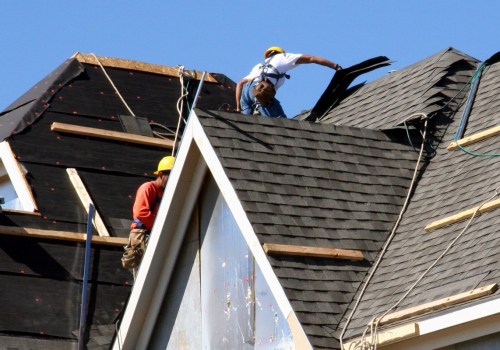A head wall is a level junction in which a ceiling meets a wall. This illustration shows a suitable flashing in a head wall condition. The top wall flashing should extend up behind the outer wall cladding and down over the roofing material, as you can see here. Flashing is required at all intersections between ceiling and wall.
A continuous L-shaped metal flashing or a stepped flashing is used to prevent water from entering the wall where a pitched roof intersects a vertical wall. Step flashing is used with tile roofs; continuous flashing is used with metal-rubber membrane roofs. However, if you were to use IKO's Crowne SlateTM, with an exposure of 10 inches (254 mm), you would need a 10 x 12 inch (254 mm x 304 mm) staggered flash piece. The stepped flashing is the most time-consuming of all roof flashing jobs because you have to complete it step by step as you climb the roof shingles.
There are some general best practices you should be aware of. First, the stepped flashing must be installed before cladding, so that the liner can cover the top of the flashing. If it is repair work, the coating must also be removed and replaced with the flashing. Second, flashing should extend 8 to 14 inches above shingles, according to the National Roofing Contractors Association (NRCA).
Some types of flashing, such as step flashing, may be more difficult to reuse because it is more difficult to separate them from old shingles without denting or otherwise damaging them. Usually, a roofer will replace the stepped flashing on a new roof. Often, with new construction, the roof flashing is first nailed to the wall. Then, the house envelope and the outer wall cladding are installed on this flashing.
Sometimes there is a problem with the differences in movement of the wall and the roof platform when the flashing is fixed to both the wall and the ceiling. These instructions are just to help homeowners understand what to expect from their roofing professional. Flashings shall be installed at the intersections of walls and ceilings, provided there is a change in the slope or direction of the roof and around the roof openings. You don't have to make custom corner flashing pieces when the ceiling is connected to a wall with no intermediate corners.
If a wall corner is on the roof, you will need to create a corner flashing piece with a typical flashing piece. A flashing shall be installed to divert water from where the eaves of a pitched roof intersects a vertical side wall. To decide whether the flashing can be reused or not, the roofer will need to remove the flashing carefully to avoid damaging it. For example, if a roofer is doing repair work on a relatively new roof and the flashing appears to be in good condition, it can be recovered.
This illustration shows the stepped flashing on the shingles and the buttress whose upper edge is placed on the mortar joints; this flashing approach would correspond to the intersection of a pitched roof along a brick wall. Before you learn how to install roof flashing, you need to understand that there are three main techniques, each suitable for different areas of the roof. The chimney flashing must be installed at the same time as the bricklayer lays the brick and mortar, or the roofer will have to cut a ridge for the counterweight. While there are prefabricated flashing parts you can buy, many roofing professionals will cut their own sheet metal roof flashings.



